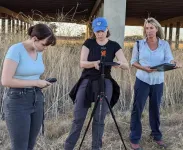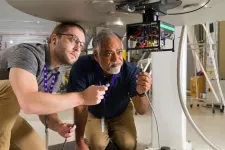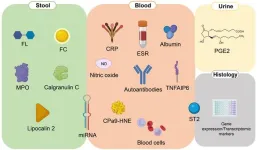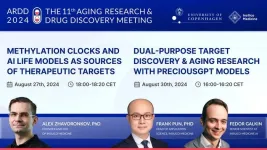(Press-News.org) Researchers from the University of Colorado College of Nursing and CU School of Medicine on the Anschutz Medical Campus were awarded a $1.35 million grant from the Agency for Healthcare Research and Quality (AHRQ) to design and implement technologies that improve resident safety and employee wellbeing at long-term care facilities.
“Long-term care facilities in the United States are in crisis, they’re facing low resources and high staff turnover,” CU Nursing Associate Professor and CU School of Medicine Faculty Member Mustafa Ozkaynak, PhD, says. “With high turnover, all the training investments for employees are gone if that employee leaves. Then, those trainings become very limited, which is a problem. So resident outcomes and staff outcomes are intertwined.”
The research team, led by Ozkaynak, will create and pilot decision support technologies tailored for long-term care facilities. These digital tools, such as alerts and predictions, provide timely patient and condition information that help providers make informed care decisions. The technologies increase patient safety and decrease staff burnout in hospitals and primary care settings.
There is limited research on how these tools could address the unique challenges facing long-term care facilities.
“Poor quality of care and safety in long-term care facilities — particularly for persons living with dementia — leads to preventable falls, emergency visits, hospitalizations, injuries, and even increased mortality. It was made even more obvious to the public during the COVID-19 pandemic, so we need to work in this area and disseminate foundational knowledge to improve care,” Ozkaynak says.
This study will be conducted in three parts over three years. In year one, researchers will focus on understanding how employees in long-term care facilities work by analyzing policies, rules, procedures, and the work culture. Researchers will conduct workshops with residents and learn how to implement decision technology to improve their care. Decision support technologies will be implemented at the end of year two, and researchers will evaluate how staff use them.
Research will start in the fall of 2024 at two assisted living communities in the Denver Metro and a nursing home in rural Wyoming.
“This is a very exciting opportunity,” Ozkaynak says. “We think this is going to be an area where we can make a huge difference because it’s very understudied. Anything we do will hopefully lead to additional studies, which will help better the long-term care healthcare system.”
CU Nursing Assistant Professor Dawon Baik, PhD, RN, and CU School of Medicine Professor of Medicine Cari Levy, MD, PhD are also part of the research team, along with other CU Nursing faculty and research assistants. CU Nursing’s PhD students will also have an opportunity to take part in the research.
About the University of Colorado Anschutz Medical Campus
The University of Colorado Anschutz Medical Campus is a world-class medical destination at the forefront of transformative science, medicine, education, and patient care. The campus encompasses the University of Colorado health professional schools, more than 60 centers and institutes, and two nationally ranked independent hospitals - UCHealth University of Colorado Hospital and Children's Hospital Colorado - that treat more than two million adult and pediatric patients each year. Innovative, interconnected, and highly collaborative, the University of Colorado Anschutz Medical Campus delivers life-changing treatments, patient care, and professional training and conducts world-renowned research fueled by over $650 million in research grants. For more information, visit www.cuanschutz.edu.
END
CU researchers awarded $1.35 million grant to develop decision support technology for long-term care facilities
Study will create and test digital tools to improve resident safety and employee wellbeing
2024-08-22
ELSE PRESS RELEASES FROM THIS DATE:
Alzheimer’s drug may someday help save lives by inducing a state of “suspended animation”
2024-08-22
Researchers at the Wyss Institute for Biologically Inspired Engineering at Harvard University report that they were able to successfully put tadpoles of Xenopus laevis frogs into a hibernation-like torpor state using donepezil (DNP), a drug approved by the FDA to treat Alzheimer’s. The team had previously used another drug, SNC80, to achieve similar results in tadpoles and enhance the survival of whole mammalian hearts for transplants, but SNC80 is not approved for clinical use in humans because it can cause seizures. By contrast, DNP is already being used in the clinic, meaning it potentially could be rapidly repurposed ...
New NSF Center for Pandemic Insights
2024-08-22
Preventing the next pandemic begins before diseases emerge. This “pre-emergence” phase is the focus of a new center funded by the U.S. National Science Foundation and led by the University of California, Davis.
Supported with $18 million over seven years, the U.S. National Science Foundation Center for Pandemic Insights (NSF CPI) includes partnering institutions from across the United States. It aims to harness new technologies and develop sensing to detect, investigate, and ultimately prevent ...
FAMU-FSU College of Engineering research shows how insulin, zinc and pH can block harmful protein clumps linked to Type 2 diabetes
2024-08-22
An estimated 462 million people around the world suffer from Type 2 diabetes, a chronic disease in which the body has problems using sugar as a fuel, leading to a buildup of sugar in the blood and chronic health issues.
New research led by Ayyalusamy Ramamoorthy, a professor at the FAMU-FSU College of Engineering and the Florida State University-headquartered National High Magnetic Field Laboratory, shows how zinc, pH levels and insulin work together to inhibit the buildup of protein clumps that contribute to this disease. The work, which points toward promising avenues for innovative treatments, ...
Fecal, blood, and urinary biomarkers in inflammatory bowel diseases
2024-08-22
The global burden of inflammatory bowel diseases (IBD), primarily Crohn's disease (CD) and ulcerative colitis (UC), continues to rise. Recent data show incidence rates of up to 17.8 cases per 100,000 person-years for CD and even higher for UC, reaching 28.4 per 100,000 person-years. These diseases primarily affect older populations and vary geographically, with higher prevalence rates in highly developed countries. Currently, endoscopic assessment through ileo-colonoscopy is the gold standard for diagnosing and monitoring IBD. However, this approach is invasive and often has limited availability, leading to long ...
ARDD 2024 | What can we do before the "cliff" of aging arrives?
2024-08-22
When exactly does the aging process start? With the aging mechanisms unclear, no consensus has been reached about aging “cliffs”, where our body functions and biological processes just change dramatically, as if overnight.
In 2019, a study published in the authoritative peer-reviewed journal Nature Medicine, based on plasma proteomics data, identified 34, 60, and 78 years old as key time points of aging. In August 2024, Nature Aging, a Nature portfolio journal focusing on aging mechanisms, published the latest findings incorporating comprehensive data including transcriptomics and metabolomics, pinpointing the aging cliffs to the 40s and 60s.
In the biomedical field, multi-omics ...
Hydrogels can play Pong by “remembering” previous patterns of electrical simulation
2024-08-22
Non-living hydrogels can play the video game Pong and improve their gameplay with more experience, researchers report August 23 in the Cell Press journal Cell Reports Physical Science. The researchers hooked hydrogels up to a virtual game environment and then applied a feedback loop between the hydrogel’s paddle—encoded by the distribution of charged particles within the hydrogel—and the ball’s position—encoded by electrical stimulation. With practice, the hydrogel’s accuracy improved by up to 10%, resulting in longer rallies. The researchers say that this demonstrates ...
Precision drug olaparib may be effective without hormone therapy for some men with biochemically recurrent prostate cancer
2024-08-22
The anti-cancer drug olaparib may be effective in treating biochemically recurrent prostate cancer without accompanying hormone therapy for men who have mutations in genes such as BRCA2, according to results of a phase II clinical trial of 51 patients conducted at the Johns Hopkins Kimmel Cancer Center and three other sites.
The study was done of men experiencing signs of cancer recurrence after surgical removal of the prostate, as measured by a high level of the protein prostate-specific antigen (PSA). Following treatment with olaparib, 13 participants, including all 11 who had BRCA2 mutations, had a decrease in PSA of at least 50% ...
Americans face disparities in exposure to tobacco on streaming platforms
2024-08-22
Tens of millions of Americans are being exposed to tobacco content on streaming services, according to new research from The University of Texas MD Anderson Cancer Center. The researchers found that the odds of encountering tobacco products being advertised, marketed or promoted on these platforms increased based on race, ethnicity, socioeconomic status and smoking habits.
The nationally representative study, published today in JAMA Network, revealed an estimated 12.4% of American adults were exposed to tobacco promotion on streaming services. Exposure was highest among those with a high school education or less (16.4%), Black/African American respondents (19.4%), ...
Elinzanetant for the treatment of vasomotor symptoms associated with menopause
2024-08-22
About The Study: In two pivotal phase 3 clinical trials, elinzanetant, a selective neurokinin-1,3 receptor antagonist, demonstrated statistically significant reductions in vasomotor symptoms (VMS) frequency and severity vs placebo in postmenopausal individuals with moderate to severe VMS. Elinzanetant also significantly improved sleep disturbances and menopause-related quality of life vs placebo; the safety profile was favorable.
Corresponding Author: To contact the corresponding author, JoAnn V. Pinkerton, ...
Trends in children’s exposure to food and beverage advertising on television
2024-08-22
About The Study: In this repeated cross-sectional study of children’s exposure to food-related television advertisements, exposure via children’s programming decreased substantially. However, most advertisements seen were still for unhealthy products, and exposure from all programming remained substantial. Findings of more than 90% of advertising exposure not from children’s programming and more than 1,000 food-related advertisements seen per year suggest the need for government regulations based on time of day rather than programming.
Corresponding Author: To contact the corresponding author, Lisa M. Powell, PhD, email powelll@uic.edu.
To ...
LAST 30 PRESS RELEASES:
Orthopedics can play critical role in identifying intimate partner violence
Worms as particle sweepers
Second spider-parasitic mite described in Brazil
January 2026 issues of APA journals feature new research on autism, pediatric anxiety, psychedelic therapy, suicide prevention and more
Private equity acquired more than 500 autism centers over the past decade, new study shows
New cervical cancer screening guidelines from the US Department of Health and Human Services
Estimated burden of COVID-19 illnesses, medical visits, hospitalizations, and deaths in the US from October 2022 to September 2024
Smartphone use during school hours by US youth
Food insecurity and adverse social conditions tied to increased risk of long COVID in children
Earliest, hottest galaxy cluster gas on record could change our cosmological models
Greenland’s Prudhoe Dome ice cap was completely gone only 7,000 years ago, first GreenDrill study finds
Scientific validity of blue zones longevity research confirmed
Injectable breast ‘implant’ offers alternative to traditional surgeries
Neuroscientists devise formulas to measure multilingualism
New prostate cancer trial seeks to reduce toxicity without sacrificing efficacy
Geometry shapes life
A CRISPR screen reveals many previously unrecognized genes required for brain development and a new neurodevelopmental disorder
Hot flush treatment has anti-breast cancer activity, study finds
Securing AI systems against growing cybersecurity threats
Longest observation of an active solar region
Why nail-biting, procrastination and other self-sabotaging behaviors are rooted in survival instincts
Regional variations in mechanical properties of porcine leptomeninges
Artificial empathy in therapy and healthcare: advancements in interpersonal interaction technologies
Why some brains switch gears more efficiently than others
UVA’s Jundong Li wins ICDM’S 2025 Tao Li Award for data mining, machine learning
UVA’s low-power, high-performance computer power player Mircea Stan earns National Academy of Inventors fellowship
Not playing by the rules: USU researcher explores filamentous algae dynamics in rivers
Do our body clocks influence our risk of dementia?
Anthropologists offer new evidence of bipedalism in long-debated fossil discovery
Safer receipt paper from wood
[Press-News.org] CU researchers awarded $1.35 million grant to develop decision support technology for long-term care facilitiesStudy will create and test digital tools to improve resident safety and employee wellbeing






